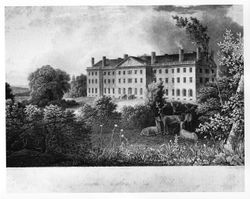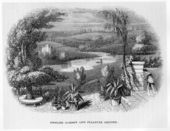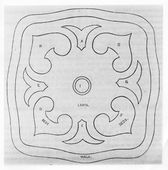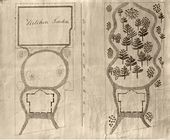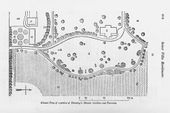English style
(a l'Anglaise, English garden, English gardening)
See also: Modern style
History
Several descriptions identified gardens in the English style or taste and then listed the very features that defined it: shrubberies, fine avenues, serpentine walks, flower beds, and lawns. Treatises tended more often to use the terms “modern style” or “landscape garden” to identify this same mode. The term “English” was used by J. C. Loudon in The Suburban Gardener, and Villa Companion (1838) in an entry about the history of gardens since the Renaissance. He, like many treatise authors before him, attributed the perfection of the natural or modern style of landscape gardening to the English in the first half of the 18th century. This tendency in garden literature led to the synonymous use of the words “English” and “modern” (or “natural”) style, even though the ancient or geometric style was practiced in England as well.
Loudon described the “vague general idea” of the English style, which he also referred to as the irregular or natural, to be one in which the grounds and plantations were formed in flowing lines in imitation of nature. He contrasted it to the geometrical style of landscape gardening, where the ground was laid out in straight lines. It was also used as an umbrella term covering the more subtle and complex modes of the picturesque, gardenesque, and rustic.
A. J. Downing's clear preference for the English style, and his conflation of it with the modern style, was repeated throughout his writing. The parallel association of French with ancient or geometric, another common trope of garden writing, often was played against the English style. Downing believed that the English lawn, which he claimed “had become proverb,” was superior to the French parterre. This idea prevailed in spite of the popularity of the natural style in the 18th and 19th centuries in France, a fashion of which he was well aware.
In 1800, Dr. Codman curiously used the French phrase “à l’anglaise” to describe the transformation of his estate in Lincoln, Massachusetts, from the ancient to the modern or natural style. His use of French was ironic since he was opting for an English style in the renovation of his grounds. Downing wrote that the name “English” or “natural” style was used on the European continent for the style he called “modern.”
Downing recommended to his readers “The English Garden” (1772–81), a long poem by William Mason, the English poet and garden designer, because it detailed the history of the rise of the landscape garden and flower garden in England. Downing described it as “devoted to the improvement of Landscape Gardening in the modern or natural style.” In this passage, Downing brought together all the associated terms: English, modern, natural, and landscape gardening, which illustrated how fluid they were in meaning and interpretation.
—Therese O'Malley
Texts
Usage
- Murray, William, June 18, 1753, in a letter to his cousin, John Murray, describing Murraywhaite, home of John Murray, Charleston, SC (Colonial Williamsburg Foundation)
- “By all means mention the fine Improvements of your garden & the fine avenues you’ve raised near the spot where you’re to build your new house. I hope you’ll raise it in the English Taste. . . You’ll certainly dig a Fish pond & another for geese & Ducks & one Swan. . . I hope you’ll raise it [the garden] in the English Taste & Leave near it proper accommodations for Hogs & Poultry to be hatched after the Chinese fashion.”

- Morse, Jedidiah, 1789, describing Mount Vernon, plantation of George Washington, Fairfax County, VA (1789: 381)[1]
- “On either wing is a thick grove of different, flowering forest trees. Parallel with them, on the land side, are two spacious gardens, into which one is led by serpentine gravel-walks, planted with weeping willows and shady shrubs. . . A lofty portico, 96 feet in length, supported by eight pillars, has a pleasing effect when viewed from the water; and the toute ensemble (the whole assemblage), of the green-house, school-house, offices and servants halls, when seen from the land side, bears a resemblance to a rural village—especially as the lands in that side are laid out somewhat in the form of English gardens, in meadows and grass grounds, ornamented with little copses, circular clumps and single trees.” [Fig. 1]

- Latrobe, Benjamin Henry, June 14, 1796, describing Horsdumonde, house of Col. Henry Skipwith, Cumberland County, VA (quoted in Carter, Van Horne, and Brownell 1985: 80–81)[2]
- “In other respects there is a great deal of worldly beauty and convenience about it. The house is a strange building, but whoever contrived it, and from whatever planet he came he was not a Lunatic, for there is much comfort and room in it, though put together very oddly. Before the South front is a range of hills wooded very much in the Stile of an English park. To the East runs the Apomatox to which a lawn extends.” [Fig. 2]
- Niemcewicz, Julian Ursyn, June 9, 1798, describing Mount Vernon, plantation of George Washington, Fairfax County, VA (quoted in Norton and Schrage-Norton 1985: 144)[3]
- “One sees also in the garden lilies, roses, pinks, etc. The path which runs all around. . . In a word the garden, the plantations, the house, the whole upkeep, proves that a man born with natural taste can divine the beautiful without having seen the model. The Gl. has never left America. After seeing his house and his gardens one would say that he had seen the most beautiful examples in England of this style.”
- Codman, Dr. John, July 18, 1800, in a letter to Mrs. Codman, describing the Grange, estate of Dr. John and Sarah Codman, Lincoln, MA (Hammond 1982: 170)[4]
- “Mrs. Gore and myself have been planning improvements at Lincoln, she says it is the handsomest place in America and might be made a l’Anglaise with ease. I like her plan that the fore-yard should be thrown down into a lawn that carriages may drive to the front door.”
- Clitherall, Eliza Caroline Burgwin, active 1801, describing the Hermitage, seat of John Burgwin, Wilmington, NC (quoted in Flowers 1983: 125)[5]
- “The Gardens were large, and laid out in the English style—a Creek wound thro’ the largest, upon its banks grew native shrubbery; in this Garden were several Alcoves, Summer Houses, a hothouse—an Octagon summer house high and a Gardener’s tool house beneath—a fishpond, communicating with the Creek, both producing abundance of fish—The Second Garden was ornamental, and in front—The ‘Cook’s Garden,’ was on the opposite side to the large.”
- Michaux, François André, 1802, describing The Woodlands, seat of William Hamilton, near Philadelphia, PA (1805: 27)[6]
- “The absence of Mr. W. Hamilton deprived me of the pleasure of seeing him. I visited his magnificent garden, situated by the side of the Schuylkill, four miles from Philadelphia. His collection of exotic plants is very considerable, particularly in those from New Holland. All the trees and shrubs of the United States, at least those which can support the winter in the open air at Philadelphia, are distributed among the groves of an English garden. It would be difficult to meet with a situation more agreeable than that of Mr. Hamilton’s residence.” [Fig. 3]
- Jefferson, Thomas, July 1806, in a letter to William Hamilton, describing plans for his plantation, Monticello, Charlottesville, VA (1944: 323)[7]
- “The grounds which I destine to improve in the style of the English gardens are in a form very difficult to be managed. They compose the northern quadrant of a mountain for about 2/3 of its height & then spread for the upper third over its whole crown. They contain about three hundred acres, washed at the foot for about a mile, by a river of the size of the Schuylkill. The hill is generally too steep for direct ascent, but we make level walks successively along it’s side, which in its upper part encircle the hill & intersect these again by others of easy ascent in various parts. They are chiefly still in their native woods, which are majestic, and very generally a close undergrowth, which I have not suffered to be touched, knowing how much easier it is to cut away than to fill up. The upper third is chiefly open, but to the South is covered with a dense thicket of Scotch broom. . . which being favorably spread before the sun will admit of advantageous arrangement for winter enjoyment. You are sensible that this disposition of the ground takes from me the first beauty in gardening, the variety of hill & dale, & leaves me as an awkward substitute a few hanging hollows & ridges, this subject is so unique and at the same time refractory, that to make a disposition analogous to its character would require much more of the genius of the landscape painter & gardener than I pretend to. . . Should I be there you will have an opportunity of indulging on a new field some of the taste which has made the Woodlands the only rival which I have known in America to what may be seen in England.”
- Boudinot, Elias, 1809, describing the garden of Stephen Higginson, Brookline, MA (quoted in Emmet 1996: 9)[8]
- “The grounds around [the house] laid out much in the English style—The Shrubbery & Forest Trees extremely well arranged—The Walks beautifully romantic—The Kitchen garden at a distance, & thro’ Which Walks wind so as to extend them about a quarter of a mile, all bordered with Grapes & Flowers.”
- Foster, Sir Augustus John, 1812, describing Montpelier, plantation of James Madison, Montpelier Station, VA (1954: 142)[9]
- “There are some very fine woods about Montpelier, but no pleasure grounds, though Mr. Madison talks of some day laying out space for an English park, which he might render very beautiful from the easy graceful descent of his hills into the plains below.”
- Hovey, C. M. (Charles Mason), September 1840, “Notes on Gardens and Gardening, in New Bedford, Mass.,” describing the estate of James Arnold, New Bedford, MA (Magazine of Horticulture 6: 363)[10]
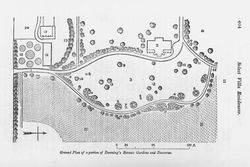
- “Mr. Arnold’s grounds are decidedly the most ornamental that we have ever seen, and convey to those who have not a good conception of the modern or English style of gardening, a better idea of what this style consists in, than they could learn by reading a hundred descriptions of the same.”
- Hovey, C. M. (Charles Mason), November 1841, describing the residence of Mr. Downing, Newburgh, NY (Magazine of Horticulture 7: 402) [11]
- “Mr. Downing’s house is situated on the upper piece, or that farthest from the river, and the annexed ground plan represents a portion of this lot, laid out in the modern or English style.” [Fig. 4]
- Earle, Pliny, 1845, describing the Bloomingdale Asylum for the Insane, New York, NY (Hawkins 1991: 89)[12]
- “. . . a liberal space, which is laid out and planted in one of the most approved styles of English gardening. This having been done in the earliest years of the institution, the trees, of which there is a great variety, have many of them attained their full growth; and as, from year to year, deficiencies have been supplied and the variety increased, the grounds will favorably compare with most in the country.” [Fig. 5]
- Lyell, Sir Charles, 1849, describing Natchez, MS (1849: 2:153)[13]
- “Many of the country-houses in the neighborhood are elegant, and some of the gardens belonging to them laid out in the English, others in the French style. In the latter are seen terraces, with statues and cut evergreens, straight walks with borders of flowers, terminated by views into the wild forest, the charms of both being heightened by contrast. Some of the hedges are made of that beautiful North American plant, the Gardenia, miscalled in England the Cape jessamine, others of the Cherokee rose, with its bright and shining leaves.”
Citations
- Loudon, J. C. (John Claudius), 1838, The Suburban Gardener (1838: 160–62)[14]
- “The prevailing Style of laying out Grounds in England is what is emphatically called English gardening; to which epithet a vague general idea is attached, of grounds and plantations formed in flowing lines, in imitation of nature; as contradistinguished from ground formed into regular slopes and levels, or plantations in straight lines, or included in plots, bounded by lines always decidedly artificial. What is called the English, or natural, style of gardening, however, may be divided into three kinds: the picturesque, the gardenesque, and the rustic. . .
- “The Irregular, Natural, or English, Style. As the lands devoted to agriculture in England were, sooner than in any other country in Europe, generally enclosed with hedges and hedgerow trees, so the face of the country in England, sooner than in any other part of Europe, produced an appearance which bore a closer resemblance to country seats laid out in the geometrical style; and, for this reason, an attempt to imitate the irregularity of nature, in laying out pleasure-grounds, was made in England, with some trifling exceptions, sooner than in any other part of the world; and hence the style became generally known as English gardening. The English, or natural style of gardening was first called landscape-gardening by Shenstone; it was also called natural gardening by Bosc, Chinese gardening by Sir W. Chambers, and picturesque gardening by Gabriel Thouin; though none of these authors, unless we except Chambers, attempted to give a correct definition of what they meant by the terms they used.”

- McIntosh, Charles, 1839, The Flower Garden (1839: 17–18)[15]
- “It is generally understood, that the style termed English in gardening consists in an artful imitation of nature, and is consequently much dependent on aspect and accessories [sic]. In the true English style, accordingly, we have neither the Italian terrace, the French parterre, nor the Dutch clipt evergreens. . . It is obvious, however, that it would require very extraordinary care and attention to render such a mode of cultivation even moderately successful, while for a flower garden it could never exhibit the beauty which a more artful and less natural disposition would insure. The art of gardening, indeed, like painting or any other fine art requires the imitation of nature not to be too close, otherwise a contrary effect will be produced to the one intended. . . The pretended adherence to nature, therefore, is wholly a style of conventional artifice, not so stiff and formal, indeed, as the Italian terraces, the French parterres, or the Dutch clipt evergreens, but still strictly artificial.” [Fig. 6]
- Downing, Andrew Jackson, 1841, A Treatise on the Theory and Practice of Landscape Gardening (1841: 17–19)[16]
- “It has been asserted by continental authors, that the English borrowed their ideas of the natural style from the Chinese. But the assertion is destitute of foundation. The gardens of the Chinese, as illustrated by Sir William Temple in a work about that period, though characterized by great irregularity, are full of littlenesses and puerile conceits, far below the standard of natural beauty aimed at by the English.
- “Among other authors whose works were devoted to the improvement of Landscape Gardening in the modern or natural style, we shall mention the following principal ones in addition to those already quoted, for the benefit of the reader who wishes to pursue the subject further than we are able to lead him. Mason’s Essay on Design in Gardening, first Gardening, 1770. The English Garden, a poem, by W. Mason, in 1782. Price’s Essays on the Picturesque, and on the use of studying pictures with a view to the improvement of real Landscape, 1794. Horace Walpole’s History of Modern Gardening, published in 1782. Repton’s Observations on the Theory and Practice of Landscape Gardening, in 1795. Among French authors we will only refer to Girardin, whose work De la Composition des Paysages, was published in 1783, and the Abbe De Lille, the author of an exquisite poem on this subject, Les Jardins, in 1820. . .
- “On the continent of Europe, though there are a multitude of examples of the modern style of landscape gardening, which is there called the English or natural style, yet in the neighbourhood of many of the capitals, especially those of the south of Europe, the taste for the geometric or ancient style of gardening still prevails to a considerable extent—partially no doubt because that style admits, with more facility, of those classical and architectural accompaniments of vases, statues, busts, etc.—the passion for which pervades a people rich in ancient and modern sculptural works of art.”
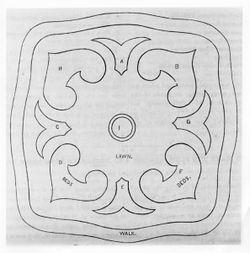
- Downing, Andrew Jackson, May 1848, “Design for a Small Flower Garden” (Horticulturist 2: 503)[17]
- “The old geometric flower gardens, laid out with long beds, bordered with box, and separated by stiff gravel walks, are fast giving place to those more tasteful combinations of masses of gay, perpetual flowering plants, arranged upon turf, in the arabesque or English style.
- “In the former, you have a miscellaneous collection of plants, of all sizes and habits of growth, only a small part of which are seen in bloom at one time; while at almost all seasons naked stalks of plants, and bare dry soil borders, appear here and there, almost in spite of the best efforts of the gardener, to disfigure and mar the general elegance of the scene.
- “In the latter, you have always the rich setting of the soft green turf, (which, of course mown once a fortnight, is short and velvet-like) and contrasting and enhanced in effect by this, are seen the beds of dwarfish plants, grown in masses, so as to give breadth and brilliancy of effect; these being composed only of plants almost perpetually in bloom, unite to form a floral picture, when well managed, as beautiful as the art of gardening will permit.” [Fig. 7]
- Downing, Andrew Jackson, 1849, A Treatise on the Theory and Practice of Landscape Gardening (1849; repr., 1991: 38–39, 430–31, 435)[18]
- “On the continent of Europe, though there are a multitude of examples of the modern style of landscape gardening, which is there called the English or natural style, yet in the neighborhood of many of the capitals, especially those of the south of Europe, the taste for the geometric or ancient style of gardening still prevails to a considerable extent; partially, no doubt, because that style admits, with more facility, of those classical and architectural accompaniments of vases, statues, busts, etc., the passion for which pervades a people rich in ancient and modern sculptural works of art. . .
- “In the United States, it is highly improbable that we shall ever witness such splendid examples of landscape gardens as those abroad, to which we have alluded. Here the rights of man are held to be equal; and if there are no enormous parks, and no class of men whose wealth is hereditary, there is, at least, what is more gratifying to the feelings of the philanthropist, the almost entire absence of a very poor class in the country; while we have, on the other hand, a large class of independent landholders, who are able to assemble around them, not only the useful and convenient, but the agreeable and beautiful, in country life. . .
- “In the English flower-garden, the beds are either in symmetrical forms and figures, or they are characterized by irregular curved outlines. The peculiarity of these gardens, at present so fashionable in England, is, that each separate bed is planted with a single variety, or at most two varieties of flowers. Only the most striking and showy varieties are generally chosen, and the effect, when the selection is judicious, is highly brilliant. Each bed, in its season, presents a mass of blossoms, and the contrast of rich colors is much more striking than in any other arrangement. . .

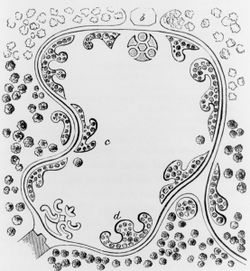
- “To illustrate the mode of arranging the beds and disposing the plants in an English garden, we copy the plan and description of the elegant flower-garden, on the lawn at Dropmore, the beds being cut out of the smooth turf.
- “The flower-garden at Dropmore is shown. . . In this the plants are so disposed, that when in flower the corresponding forms of the figure contain corresponding colored flowers. The following is a list of the plants which occupy this figure during summer, with the order in which they are disposed: and a corresponding enumeration of the bulbs and other plants which occupy the beds during winter and spring. [Fig. 8]
- “We give an example of a small cottage or villa residence of one or two acres, where the flower-beds are disposed around the lawn in the English style: their forms irregular, with curved outlines, affording a great degree of variety in the appearance as viewed from different points on the lawn itself. In this, the central portion is occupied by the lawn; c, d, are the flower-beds, planted with showy border-flowers, in separate masses; b, the conservatory. Surrounding the whole is a collection of choice shrubs and trees, the lowest near the walk, and those behind increasing in altitude as they approach the boundary wall or fence. In this plan, as there is supposed to be no exterior view worth preserving, the amphitheatre of shrubs and trees completely shuts out all objects but the lawn and its decorations, which are rendered as elegant as possible.” [Fig. 9]
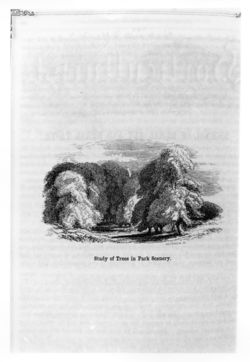
- Downing, Andrew Jackson, September 1851, “Study of Park Trees” (Horticulturist 6: 427)[19]
- “There is as much difference between a wild forest tree and a park tree, as between a wild horse and the finest trained Arabian courser. Full, as our forests are, of native trees in the richest variety to be found on the globe, but few Americans are familiar with the beauty of finely developed trees. Even in our ornamental grounds, it is too much the custom to plant trees in masses, belts, and thickets—by which the same effects are produced as we constantly see in ordinary wood—that is, there is picturesque intricacy, depth of shadow, and seclusion, growing out of masses of verdure— but no beauty of development in each individual tree—and none of that fine perfection of character which is seen when a noble forest tree stands alone in soil well suited to it, and has ‘nothing else to do but grow’ into the finest possible shape that nature meant it to take.
- “One sees such trees, to be sure, occasionally, all over the country. Witness the elms of the Connecticut valley, the maples of the Housatonic, the tulip trees of Pennsylvania, and the oaks of Western New-York. But there are two places where this kind of park-like development of trees, is most perfect and complete.
- “The first is, in the English Parks—those broad grassy surfaces, studded with scattering trees and groups of trees—hundred of years old—many of them allowed to grow into the most beautiful forms that nature has impressed into their organization, and spread out into the richest drooping umbrageous heads of foliage that so favorable a climate for their growth can beget.” [Fig. 10]
Images
Inscribed
Anonymous, English Garden and Pleasure Ground, in Charles McIntosh The Flower Garden, p. 17.
Anonymous, “A Small Arabesque Flower Garden,” in A. J. Downing, ed., Horticulturist 2, no. 11 (May 1848): 504.
Anonymous, “The Flower-Garden at Dropmore,” in A. J. Downing, A Treatise on the Theory and Practice of Landscape Gardening (1849): 431, fig. 77.
Anonymous, “English Flower-Garden,” in A. J. Downing, A Treatise on the Theory and Practice of Landscape Gardening (1849): 434, fig. 78.
Associated
William Groombridge, The Woodlands, the Seat of William Hamilton, Esq., 1793. Santa Barbara Museum of Art, Gift of Mrs. Sterling Morton for the Preston Morton Collection.
Benjamin Henry Latrobe, Horsdumonde, the House of Colonel Henry Skipwith, Cumberland County, Virginia, June 14, 1796.
William Russell Birch, Potomak Front of Mount Vernon, c. 1801–3.
Anonymous, Study of trees in Park Scenery, in A. J. Downing, “Study of Park Trees,” Horticulturist 6, no. 9 (September 1851): pl. opp. 394.
Attributed
Unknown, Kitchen Garden, Elias Hasket Derby House, c. 1795-99.
Anonymous, “Ground Plan of a portion of Downing’s Botanic Gardens and Nurseries,” in Magazine of Horticulture 7, no. 11 (November 1841): 404.
Notes
- ↑ Jedidiah Morse, The American Geography; Or, A View of the Present Situation of the United States of America (Elizabeth Town, NJ: Shepard Kollock, 1789), view on Zotero.
- ↑ Edward C. Carter II, John C. Van Horne, and Charles E. Brownell, Latrobe’s View of America, 1795–1820: Selections from the Watercolors and Sketches (New Haven: Yale University Press for the Maryland Historical Society, 1985), view on Zotero.
- ↑ John D. Norton and Susanne A. Schrage-Norton, “The Upper Garden at Mount Vernon Estate-Its Past, Present, and Future: A Reflection on 18th Century Gardening. Phase II: The Complete Report” (Mount Vernon Ladies’ Association Library, 1985), view on Zotero.
- ↑ Charles Arthur Hammond, “‘Where the Arts and the Virtues Unite’: Country Life Near Boston, 1637–1864” (PhD diss., Boston University, 1982), view on Zotero.
- ↑ John Flowers, “People and Plants: North Carolina’s Garden History Revisited,” Eighteenth Century Life 8 (1983): 117–29, view on Zotero.
- ↑ François André Michaux, Travels to the West of the Alleghany Mountains, in the States of Ohio, Kentucky, and Tennessea, and back to Charleston, by the Upper Carolines . . . Undertaken, in the Year 1802, 2nd ed. (London: B. Crosby & Co. and J. F. Hughes, 1805), view on Zotero.
- ↑ Thomas Jefferson, The Garden Book, ed. Edwin M. Betts (Philadelphia: American Philosophical Society, 1944), view on Zotero.
- ↑ Alan Emmet, So Fine a Prospect: Historic New England Gardens (Hanover, NH: University Press of New England, 1996), view on Zotero.
- ↑ Sir Augustus John Foster, Jeffersonian America: Notes on the United States of America Collected in the Years 1805–1806–1807 and 1811–1812, ed. Richard Beale Davis (San Marino, CA: Huntington Library, 1954), view on Zotero.
- ↑ Charles Mason Hovey, “Notes on Gardens and Gardening, in New Bedford, Mass.,” Magazine of Horticulture, Botany, and All Useful Discoveries and Improvements in Rural Affairs 6, no. 9 (September 1840): 361–66, view on Zotero.
- ↑ Charles Mason Hovey, “Select Villa Residences, with Descriptive Notices of Each; Accompanied with Remarks and Observations on the Principles and Practice of Landscape Gardening: Intended with a View to Illustrate the Art of Laying Out, Arranging, and Forming Gardens and Ornamental Grounds,” Magazine of Horticulture, Botany, and All Useful Discoveries and Improvements in Rural Affairs 7, no. 11 (November 1841): 401–11, view on Zotero.
- ↑ Kenneth Hawkins, “The Therapeutic Landscape: Nature, Architecture, and Mind in Nineteenth-Century America” (PhD diss., University of Rochester, 1991), view on Zotero.
- ↑ Sir Charles Lyell, A Second Visit to the United States of North America, 2 vols. (New York: Harper, 1849), view on Zotero.
- ↑ J. C. (John Claudius) Loudon, The Suburban Gardener, and Villa Companion (London: Longman et al., 1838), view on Zotero.
- ↑ Charles McIntosh, The Flower Garden: Containing Directions for the Cultivation of All Garden Flowers (London: Wm. S. Orr, 1839), view on Zotero.
- ↑ A. J. Downing, A Treatise on the Theory and Practice of Landscape Gardening, Adapted to North America; with a View to the Improvement of Country Residences . . . with Remarks on Rural Architecture (New York and London: Wiley & Putnam, 1841), view on Zotero.
- ↑ A. J. Downing, “Design for a Small Flower Garden,” Horticulturist and Journal of Rural Art and Rural Taste 2, no. 11 (May 1848): 503–5, view on Zotero.
- ↑ A. J. [Andrew Jackson] Downing, A Treatise on the Theory and Practice of Landscape Gardening, Adapted to North America, 4th ed. (1849; repr., Washington, DC: Dumbarton Oaks Research Library and Collection, 1991), view on Zotero.
- ↑ A. J. Downing, “Study of Park Trees,” Horticulturist and Journal of Rural Art and Rural Taste 6, no. 9 (September 1851): 427, view on Zotero.

